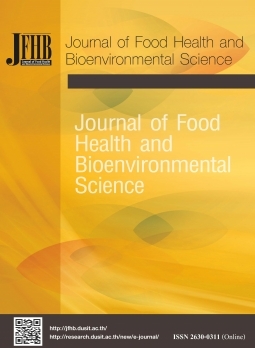Crisp Bhutan Oyster Mushroom (Pleurotus pulmonarius): A Potential Innovative Product for Commercialization
Keywords:
Food innovation, Bhutanese oyster mushrooms, Medicinal mushroom productsAbstract
This research was undertaken to create therapeutic mushroom products and disseminate knowledge to entrepreneurs. The researchers along with a community created product design and distribution channels and developed a brand for medicinal mushroom products based on the community's identity. Bhutanese oyster mushrooms were used to create mushroom products that consisted of Bhutanese oyster mushroom (88%), sugar (5%), vegetable oil (3%), soy sauce (2%), coriander seeds (1%) and salt (1%).The production method was conducted by to washing the mushrooms thoroughly, squeezing the water out and setting them aside; then mixing all ingredients together and dry in a hot air oven at 60°C for 90 min. Then the batter was fried in hot oil at 90-95°C for 5 min, and then placed in the oven at 150°C for 20 min to crisp and reduce the surface moisture of the product. The sensory preference (7.80 – 8.80 points) was at a high level. Moreover, the knowledge can be transferred to entrepreneurs to implement in real production. It is a product that has the potential to be marketed for distribution as a health food with an emphasis on semi-premium marketing which can be differentiated by demonstrating the value and nutrients of Bhutanese oyster mushrooms. This research included designing aesthetic, outstanding and unique packaging to create the identity for the community. Furthermore, a brand of medicinal mushroom products called “Hed Khik Khak or Giggling Mushrooms” was created. The feedback acceptance (99%) was at a high level. The product has been registered under the trademark for Klong Chik Sub-district Community Enterprise to be used with therapeutic mushroom products in the future.
References
AOAC. (1995). Official methods of analysis the association of official analysis chemistry. Washington, D.C.: Association of Official Analytical Chemists.
AOAC. (2000). Official methods of analysis the association of official analysis chemistry. Washington, D.C.: Association of Official Analytical Chemists.
Chantarakan, S. (2012). Development of healthy snack products from mushrooms (Master’s thesis). Bangkok: Kasetsart University.
Cedric, M., Cecile, G., Constance, D., Ferderic, J.T., Chantal, F., Emmanuelle, P., … Henri, N. (2021). Investigation of the antioxidant capacity of carmels: Combination of laboratory assays and C. elegans model. Journal of Function Foods, 78, 04308.
Cronbach, L.J. (1951). Coefficient alpha and the internal structure of tests. Psychometrika, 16 (3), 297-334.
Fellow, P. (2000). Food processing technology: Priciples and pactrice (2nd ed.). Washington, DC: Woodhead Publishing.
Fennema, O.R. (1996). Food chemistry (3th ed.). New York: Marcel Dekker.
Kaikaew, D., Wongpaisanlit, R., & Wongtom, R. (2016). Effect of sucrose syrup content on oil absorption in fried banana chip production. Food Journal, 45(2), 73-79.
Noiduang, P., Tapaothong, N., & Masileerungsri, K. (2015). Use of dried aril of gac fruit powder as an antioxidant in mayonnaise product. Journal of Food Technology, Siam University, 10(1), 9-18.
Rattananon, N. (2008). Food chemistry (2nd ed.). Bangkok: Odiantro Publishing.
Rattanathammawat, R., Suwonsichon, T., Chompreda, P., Sriroth, K., & Haruthaithanasan, V. (2003). Effect of moisture content of half-snacks and frying time on physicochemical properties of taro flour snack. Proceedings of 41st Kasetsart University Annual Conference (pp. 45-52). Bankok: Kasetsart University.
Sirilert, T., & Silalai, N. (2016). Effect of pre-frying treatments on moisture content, effective moisture diffusivity and oil uptake content of deep-fat fried shitake mushrooms (Lentinusedodes). Journal of Food Technology, Siam University, 11(1), 57-66.
Tolgahan, K., & Vural, G. (2019). Caramelization in food quality and safety perspective. Food Chemistry, 2019, 18-29.
Wei, Z., Li, X., Thushara, D., & Y, Liu. (2011). Determination and removal of malondialdehyde and other 2-thiobarbituric acid reactive substances in waste cooking oil. Journal of Food Engineering, 107(3-4), 379–384.
Wrolstad, R.E., Acree, T.E., Decker, E.A., Penner, M. H., Reid, D.S., Schwartz, S.J., ... & Sporns, P. (2005). Lipids. In Handbook of food analytical chemistry (pp. 467-564). USA: John Wiley & Sons.
Downloads
Published
How to Cite
Issue
Section
License

This work is licensed under a Creative Commons Attribution-NonCommercial-NoDerivatives 4.0 International License.








